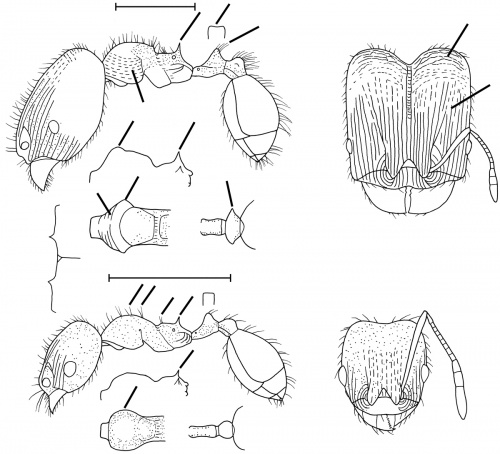Pheidole torosa
| Pheidole torosa | |
|---|---|
| Scientific classification | |
| Kingdom: | Animalia |
| Phylum: | Arthropoda |
| Class: | Insecta |
| Order: | Hymenoptera |
| Family: | Formicidae |
| Subfamily: | Myrmicinae |
| Tribe: | Attini |
| Genus: | Pheidole |
| Species: | P. torosa |
| Binomial name | |
| Pheidole torosa Wilson, 2003 | |
Nothing is known about the biology of torosa.
Identification
See the description in the nomenclature section.
Keys including this Species
Distribution
Only known from the type locality.
Latitudinal Distribution Pattern
Latitudinal Range: 29.903° to 28.633333°.
| North Temperate |
North Subtropical |
Tropical | South Subtropical |
South Temperate |
- Source: AntMaps
Distribution based on Regional Taxon Lists
Neotropical Region: Mexico (type locality).
Distribution based on AntMaps
Distribution based on AntWeb specimens
Check data from AntWeb
Countries Occupied
| Number of countries occupied by this species based on AntWiki Regional Taxon Lists. In general, fewer countries occupied indicates a narrower range, while more countries indicates a more widespread species. |

|
Estimated Abundance
| Relative abundance based on number of AntMaps records per species (this species within the purple bar). Fewer records (to the left) indicates a less abundant/encountered species while more records (to the right) indicates more abundant/encountered species. |

|
Biology
Castes
Nomenclature
The following information is derived from Barry Bolton's Online Catalogue of the Ants of the World.
- torosa. Pheidole torosa Wilson, 2003: 603, figs. (s.w.) MEXICO.
Unless otherwise noted the text for the remainder of this section is reported from the publication that includes the original description.
Description
DIAGNOSIS A member of the “pilifera complex” of the larger pilifera group, comprising Pheidole calens, Pheidole californica, Pheidole carrolli, Pheidole cavigenis, Pheidole clementensis, Pheidole creightoni, Pheidole hoplitica, Pheidole littoralis, Pheidole micula, Pheidole pilifera, Pheidole polymorpha, Pheidole rugulosa, Pheidole senex, Pheidole soritis, Pheidole tepicana and Pheidole torosa, which complex is distinguished by the following traits. Major: dorsal head surface extensively sculptured; occipital lobe transversely rugulose (or, in carrolli smooth, in littoralis foveate, and in micula and soritis carinulate); postpetiole from above diamond-shaped, trapezoidal, or spinose. Minor: eye medium-sized to large.
P. torosa is distinguished within the complex as follows.
Major: bicolorous; transverse rugulae cover posterior fifth of dorsal surface of head in full-face view, and longitudinal carinulae cover all of the remainder of the dorsal surface except the frontal triangle; humerus in dorsal-oblique view prominent and lobose; in side view, mesonotum drops almost vertically to metanotum; propodeal spines very long, stout, and vertical to propodeal basal face; seen from above, postpetiole very wide relative to petiole, and spinose.
Minor: all of head and mesosoma foveolate and opaque; pilosity along promesonotal dorsum consists of evenly spaced pairs of setae. This species is very close to and possibly synonymous with Pheidole senex.
MEASUREMENTS (mm) Holotype major: HW 1.56, HL 1.84, SL 0.76, EL 0.20, PW 0.68. Paratype minor: HW 0.58, HL 0.64, SL 0.62, EL 0.14, PW 0.32.
COLOR Major: bicolorous, with light reddish brown head and appendages contrasting with dark brown mesosoma and gaster.
Minor: concolorous light brown.
Figure. Upper: holotype, major. Lower: paratype, minor. Scale bars = 1 mm.
Type Material
MEXICO: El Sueco, Chihuahua. Museum of Comparative Zoology
Etymology
L torosa, muscular, bulging, a reference to the major caste.
References
- Wilson, E. O. 2003. Pheidole in the New World: A dominant, hyperdiverse ant genus. Harvard University Press, Cambridge, MA. (page 603, fig. major, minor described)
References based on Global Ant Biodiversity Informatics
- Vásquez-Bolaños M. 2011. Lista de especies de hormigas (Hymenoptera: Formicidae) para México. Dugesiana 18: 95-133
- Wilson, E.O. 2003. Pheidole in the New World: A Dominant, Hyperdiverse Genus. Harvard University Press
